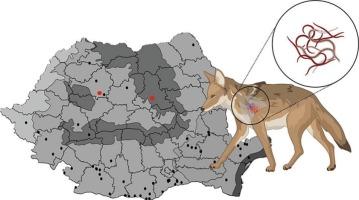金豺是罗马尼亚血管圆线虫的新宿主
IF 1.4
Q3 PARASITOLOGY
Veterinary parasitology, regional studies and reports
Pub Date : 2025-09-01
DOI:10.1016/j.vprsr.2025.101335
引用次数: 0
摘要
血管圆线虫,通常被称为法国心丝虫,是一种感染家养和野生食肉动物的超圆线虫。虽然在欧洲,红狐(Vulpes Vulpes)被认为是主要的宿主,但最近的研究表明,金豺(Canis aureus)也可以被认为是重要的宿主。由于金豺在欧洲的迅速扩张,它们在血管沙鼠流行病学中的作用尚未得到充分的探讨。本研究旨在了解罗马尼亚金豺中血管棘虫的发生情况。在2013年10月至2024年11月期间,通过合法狩猎或公路捕杀,在罗马尼亚的21个县共收集了137只金豺。进行了全面的寄生虫学尸检(其他资料见别处),并解剖了心肺系统,以寻找成虫。采用Baermann法分离第一期幼虫(L1)。用标准显微镜对线虫和幼虫进行形态学检查。采用针对ITS-2区域的PCR方法对成虫进行分子鉴定,并进行测序和系统发育分析。并对肺组织进行组织病理学分析。137只金豺中有2只在肺动脉中检出血管支原体(1.45%)。肺组织中第一阶段幼虫的存在证实了它们作为最终宿主的作用。分子测序结果显示,该菌株与来自欧洲的血管棘球蚴同源性100%。组织病理学检查显示肉芽肿性肺炎伴寄生虫卵、幼虫及与感染相关的血管改变。本研究证实了金豺是罗马尼亚血管棘虫的适宜寄主,提示了它们作为宿主的潜在作用。鉴于胡狼、家犬和红狐之间的重叠越来越多,需要进一步监测以了解血管棘球蚴在野生动物和家畜健康中的流行病学意义。本文章由计算机程序翻译,如有差异,请以英文原文为准。

Golden jackals (Canis aureus) as novel hosts for Angiostrongylus vasorum in Romania
Angiostrongylus vasorum, commonly known as the French heartworm, is a metastrongyloid nematode infecting domestic and wild carnivores. While red foxes (Vulpes vulpes) are known as the primary reservoir hosts in Europe, recent studies suggest that golden jackals (Canis aureus) could also be considered as important reservoir hosts. Due to the rapid expansion of golden jackals in Europe, their role in the epidemiology of A. vasorum remains insufficiently explored. This study aimed to assess the occurrence of A. vasorum in golden jackals from Romania. Between October 2013 and November 2024, a total of 137 golden jackals were collected from 21 counties in Romania through legal hunting or roadkill. A full parasitological necropsy was performed (other data presented elsewhere), with the cardiorespiratory tract dissected for adult nematodes. First-stage larvae (L1) were isolated using the Baermann method. Morphological examination of nematodes and larvae was conducted using standard microscopy. Molecular identification of adult nematodes was carried out using PCR targeting the ITS-2 region, followed by sequencing and phylogenetic analysis. Additionally, histopathological analysis was performed on lung tissue. A. vasorum was identified in the pulmonary arteries of 2 out of 137 golden jackals (1.45 %). The presence of first-stage larvae in lung tissue confirmed their role as definitive hosts. Molecular sequencing revealed 100 % identity with A. vasorum isolated from Europe. Histopathological examination showed granulomatous pneumonia with parasitic eggs, larvae, and vascular changes associated with the infection. This study confirms golden jackals as suitable hosts for A. vasorum in Romania, indicating their potential role as reservoir hosts. Given the increasing overlap between jackals, domestic dogs, and red foxes, further surveillance is needed to understand the epidemiological implications of A. vasorum in wildlife and domestic animal health.
求助全文
通过发布文献求助,成功后即可免费获取论文全文。
去求助
来源期刊
CiteScore
2.90
自引率
7.10%
发文量
126
审稿时长
97 days
期刊介绍:
Veterinary Parasitology: Regional Studies and Reports focuses on aspects of veterinary parasitology that are of regional concern, which is especially important in this era of climate change and the rapid and often unconstrained travel of people and animals. Relative to regions, this journal will accept papers of the highest quality dealing with all aspects of disease prevention, pathology, treatment, epidemiology, and control of parasites within the field of veterinary medicine. Also, case reports will be considered as they add to information related to local disease and its control; such papers must be concise and represent appropriate medical intervention. Papers on veterinary parasitology from wildlife species are acceptable, but only if they relate to the practice of veterinary medicine. Studies on vector-borne bacterial and viral agents are suitable, but only if the paper deals with vector transmission of these organisms to domesticated animals. Studies dealing with parasite control by means of natural products, both in vivo and in vitro, are more suited for one of the many journals that now specialize in papers of this type. However, due to the regional nature of much of this research, submissions may be considered based upon a case being made by the author(s) to the Editor. Circumstances relating to animal experimentation must meet the International Guiding Principles for Biomedical Research Involving Animals as issued by the Council for International Organizations of Medical Sciences (obtainable from: Executive Secretary C.I.O.M.S., c/o W.H.O., Via Appia, CH-1211 Geneva 27, Switzerland).

 求助内容:
求助内容: 应助结果提醒方式:
应助结果提醒方式:


